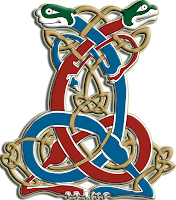
As i commented on a previous post, it is very common to find on Irish and Welsh medieval literature references to courageous warriors and brave dogs respected by their loyalty, and often given as a gift to them. Many argue Celtic hounds to be either the Greyhound, Scottish Deerhound, Irish Wolfhound or even a mix of all these breeds.
A very particular case is the one related to the The Fionn Cycle , also known as the Fenian Cycle--for Fionn's warrior band, the Fianna--the "Fionn Cycle" traces the exploits of Fionn mac Cumhaill, the wandering, woodland warrior of Irish myth. They were popular in both Ireland and Scotland, each country producing numerous narratives and poems on the subject.
Fionn may have originally been a sort of zoomorphic god, a type of Cernunnos,
the deer-horned god in Gaul. Moreover, it is Fionn who contributes
important elements of Celtic belief in wisdom through his eating of the
salmon of wisdom, and it's related theme of imbas forosnai. Moreover the mother of Bran and Sceolan was Tuiren, and was Fionn Mac Cumhaill's aunt, transformed into a hound by a fairy.
Fionn met his most famous wife, Sadhbh, when he was out hunting. She had been turned into a deer by a druid, Fear Doirich, for she had refused to marry him. Fionn's hounds,
"Bran" and "Sceolan" (Sceolan, pronounced Sky-O-Lawn or Ska-Lawn), who were once human themselves, recognised she was
human, and Fionn spared her. She transformed back into a beautiful woman
the moment she set foot on Fionn's land, as this was the one place she
could regain her true form. She and Fionn married and she was soon
pregnant. However, Fear Doirich (literally meaning Dark Man) returned
and turned her back into a deer, whereupon she vanished. Fionn spent
seven years searching for her, but to no avail. Fortunately, he was
later reunited with their son, Oisín, who went on to be one of the greatest of the Fianna.
It is usually assumed that Bran and Sceolan were Irish Wolfhounds, since this breed was used to hunt Wolves and Deer, but they were also used as war dogs to attack men on horseback and knock them from their saddles to be killed by others.
Bran and Sceolan are monstrous dogs, won by Finn from a kind of Celtic version of the monster Grendel in BEOWULF, who had been stealing babies from a young champion's house. Like their mother, they are gifted hunters with a strange mixture of colours and great savagery in other versions.
Bran is described in Bardic legends as A ferocious, white-breasted,
sleek-haunched hound; standing as high as mid-chest of a full grown man;
fiery, deep black eyes that seemed to swim in sockets of blood.
Sceolan was described as Slightly smaller than the black beast, small
headed, having eyes of a dragon, the claws of a wolf, the vigour of a
lion; and the venom of a serpent.
It is usually assumed that Bran and Sceolan were Irish Wolfhounds, since this breed was used to hunt Wolves and Deer, but they were also used as war dogs to attack men on horseback and knock them from their saddles to be killed by others.
Bran and Sceolan are monstrous dogs, won by Finn from a kind of Celtic version of the monster Grendel in BEOWULF, who had been stealing babies from a young champion's house. Like their mother, they are gifted hunters with a strange mixture of colours and great savagery in other versions.
These narratives can be found in both Ancient Irish Tales, translated by Cross & Slover, and Old Celtic Romances translated by P.W. Joyce.
Aside from these narrative tales, there were also poems
annonymously composed and put in the names of several characters; it was
translated as Duanaire Finn--The Lays of Finn in two volumes:
the first in 1908 by Eion Mac Neill, and the second in 1933 by Gerard
Murphy. These poems are taken from a single manuscript written in about
1626, but drawing on older material.
Bran is a great figure in all the legends of this
time, and he is described thus in the poem « Bran’s Departure from the
Fenians » :
Two white side had
Bran
and a fresh crimson
shining tail.
His crimson haunch
was well apportioned,
stretching from his
tail to the end of his back.
He had a fierce eye
in his shaky head.
It was impossible to
contend with him.
Beautiful and lovely
was his fame.
He was swifter than
all hare-hounds.
The tallest of the
Fian dogs would pass
beneath his groin
without stooping :
His head (it was a
cunning distribution)
was as high as my
shoulder.
Related Sources:
http://www.maryjones.us/jce/fionncycle.html
http://www.eiwc.org/pdf/doc/OCDanglaisrev..doc
http://www.eiwc.org/pdf/doc/OCDanglaisrev..doc










No comments:
Post a Comment